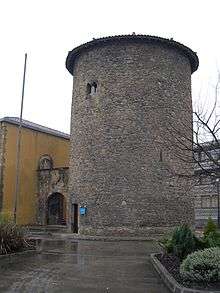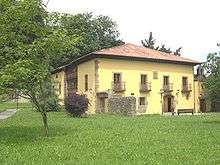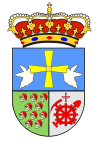Langreo
| Langreo Llangréu | |||
|---|---|---|---|
| Municipality | |||
| Llangréu / Langreo | |||
|
The town of Langreo at the Nalón Valley | |||
| |||
 Location of Llangreu | |||
 Langreo Location in Spain | |||
| Coordinates: 43°18′N 5°41′W / 43.300°N 5.683°WCoordinates: 43°18′N 5°41′W / 43.300°N 5.683°W | |||
| Country |
| ||
| Autonomous community |
| ||
| Province | Asturias | ||
| Comarca | Nalón | ||
| Government | |||
| • Mayor | Jesús Manuel Sánchez Antuña (IU) | ||
| Area | |||
| • Total | 82.46 km2 (31.84 sq mi) | ||
| Elevation | 1,021 m (3,350 ft) | ||
| Population (2010) | |||
| • Total | 45,397 | ||
| • Density | 550/km2 (1,400/sq mi) | ||
| Demonym(s) | Langreanos | ||
| Time zone | CET (UTC+1) | ||
| • Summer (DST) | CEST (UTC+2) | ||
| Dialing code |
33930(District of La Felguera) 33900(District of Sama) 33920(District of Riaño) 33909(District of Ciaño) 33934(District of Lada) | ||
| Official language(s) | Asturian | ||
| Website | Official website | ||
Langreo (Spanish pronunciation: [laŋ.ˈgɾe.o]; Asturian: Llangréu)[1] is a municipality and town of northern Spain, province of The Principality of Asturias. It is the 4th largest town of Asturias with 43.000 inhabitants. Langreo is located in the centre of Asturias, approximately 20 kilometres (12 mi) south-east of Oviedo. It was an important mining and metallurgical center.
In the neighbourhood fruit and cider are produced, and there are still important coal mines, foundries, and factories for the manufacture of coarse cloth.
History
According to a legend Langreo was the place where the Moorish governor Munuza was killed while trying to flee from Asturias at the beginning of the Reconquest. Langreo was settled by the Romans, who built a large Roman bridge that is not conserved today.
In the past, it was one of the most important mining and metallurgical points of Spain since the 18th century, and it was also well known because of workers struggles and its cultural life. The 3rd railway to be built in the Iberian Peninsula was the FC of Langreo. The Factory of La Felguera was one of the most important siderurgy centers in Spain, and the Langreo mines was well known in whole Spain.
Because of the Spanish "Industrial Restructuring", Langreo lost its industrial importance, but today it conserves important factories like Bayer, where 100% of the acetylsalicylic acid of the German enterprise is produced. Langreo also holds the technologies centre Valnalón.
Langreo has important medieval monuments like the church of San Esteban, the Quintana Tower or the Sanctuary of Carbayu. Today Langreo preserves good examples of its industrial heritage and it hosts the Siderurgy Museum Of Asturias within the old Felguera Factory, the Samuño Valley and Railway Mining Museum, and the art gallery Pinacoteca Eduardo Úrculo.
Langreo celebrates fiestas of San Pedro and Santiago, and special gastronomic days: Carnival (February) Cider (April) and Fabada (December)
The largest town is Langreo (43,000 inhabitants), formed by the most important districts: La Felguera (20.000), Sama (10.000), and Riaño, Ciaño, Lada and Barros.
Parishes
There are eight parishes (administrative divisions) by population:
People

- David Villa, footballer
- Manuel Mejuto González, football referee
- Pedro Duro, businessman
- Aurelius of Asturias, King of Asturias
- Gaspar García Laviana, soldier
- Mario Cotelo, footballer
- Alberto Coto García, mental calculator
- Dámaso Alonso, poet
- Narciso Ibáñez Menta, actor
- Jesús Fernández Duro, sportman
- María Neira, WHO doctor
- Carlos Álvarez-Nóvoa, actor
Gallery

 Langreohotel Hotel
Langreohotel Hotel- Samuño Mining and Railway Museum
 La Quintana medieval Tower
La Quintana medieval Tower La Buelga (University of Oviedo
La Buelga (University of Oviedo_20.jpg) Cuca House
Cuca House
References
External links
| Wikimedia Commons has media related to Langreo. |
![]() This article incorporates text from a publication now in the public domain: Chisholm, Hugh, ed. (1911). "article name needed". Encyclopædia Britannica (11th ed.). Cambridge University Press.
This article incorporates text from a publication now in the public domain: Chisholm, Hugh, ed. (1911). "article name needed". Encyclopædia Britannica (11th ed.). Cambridge University Press.


